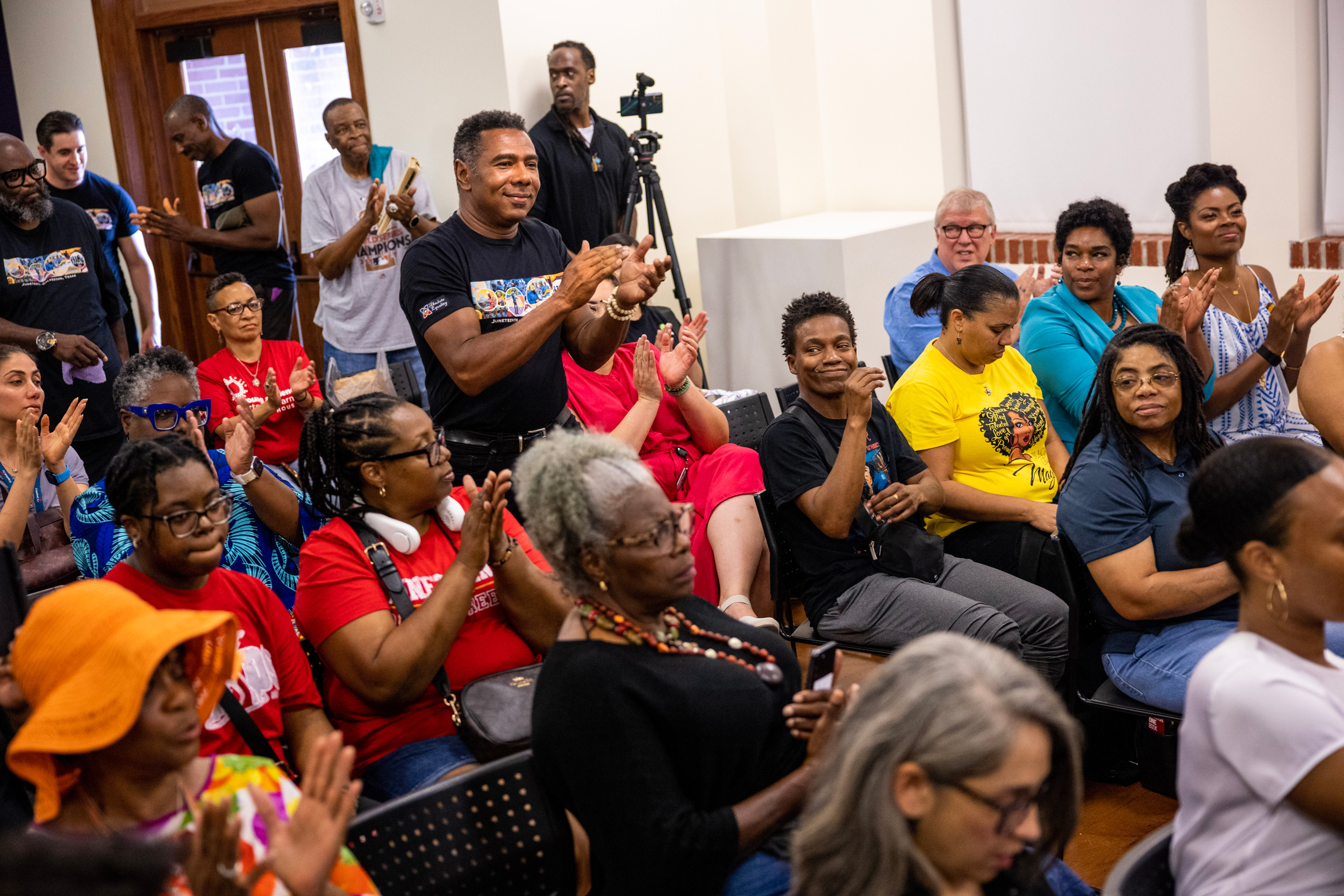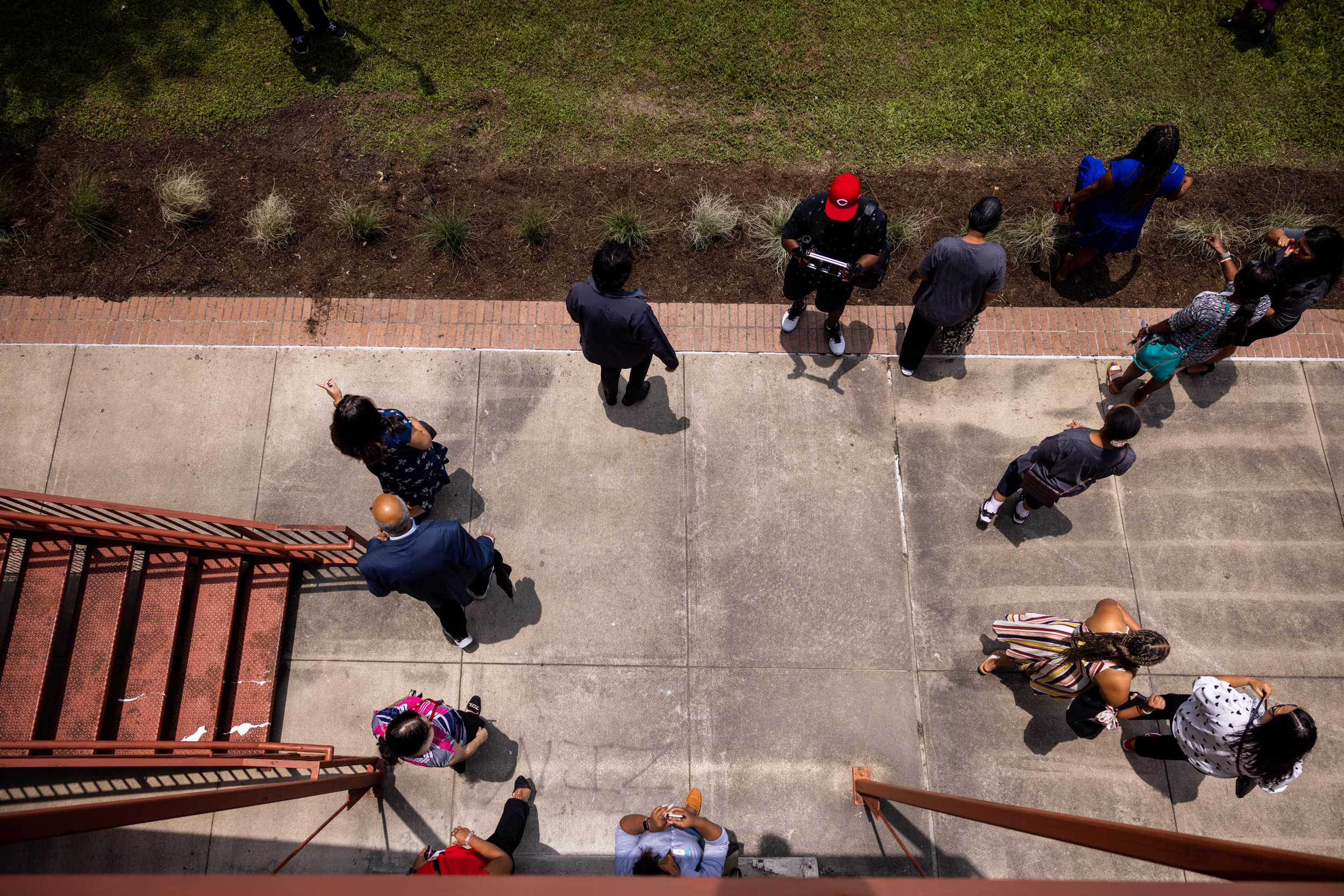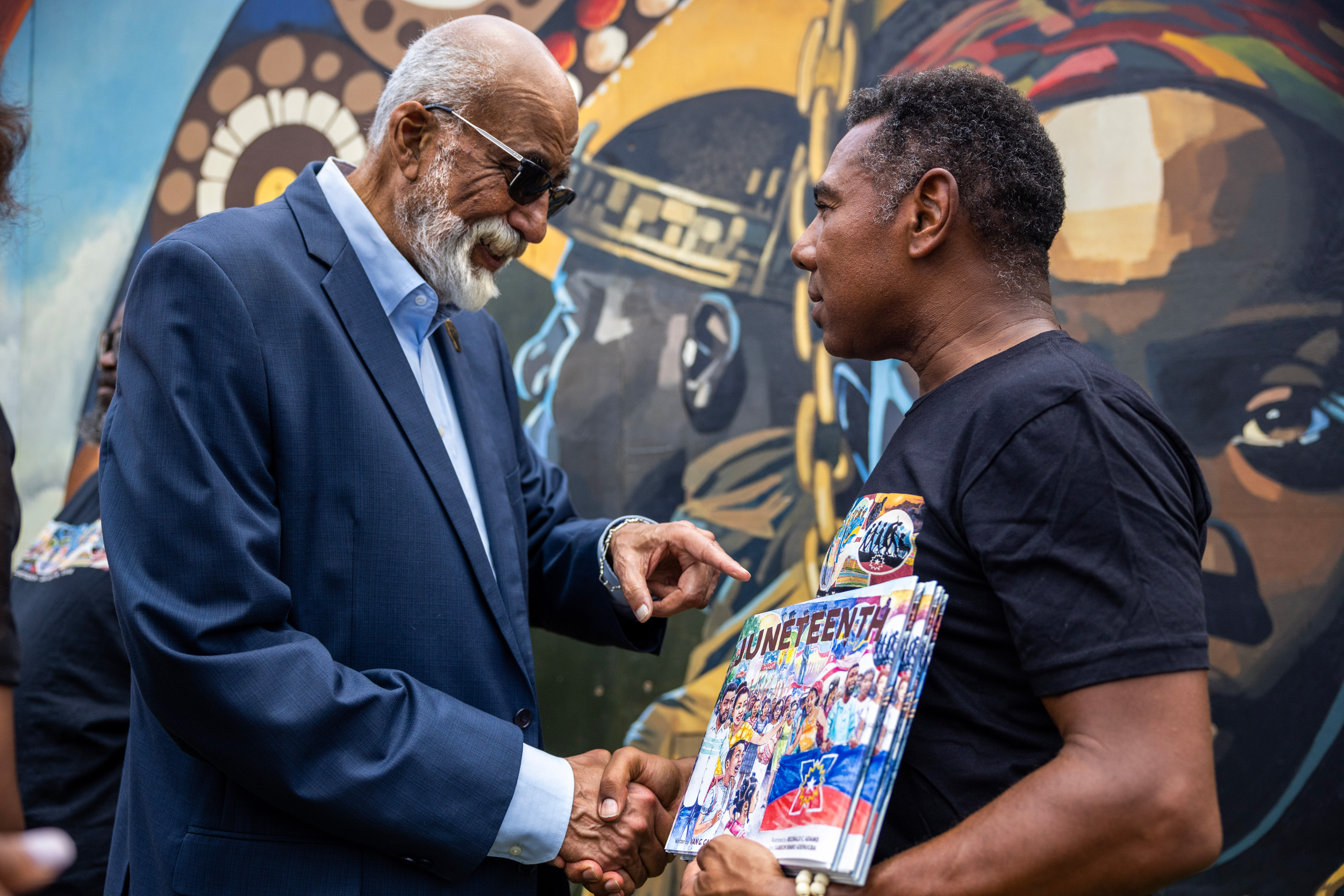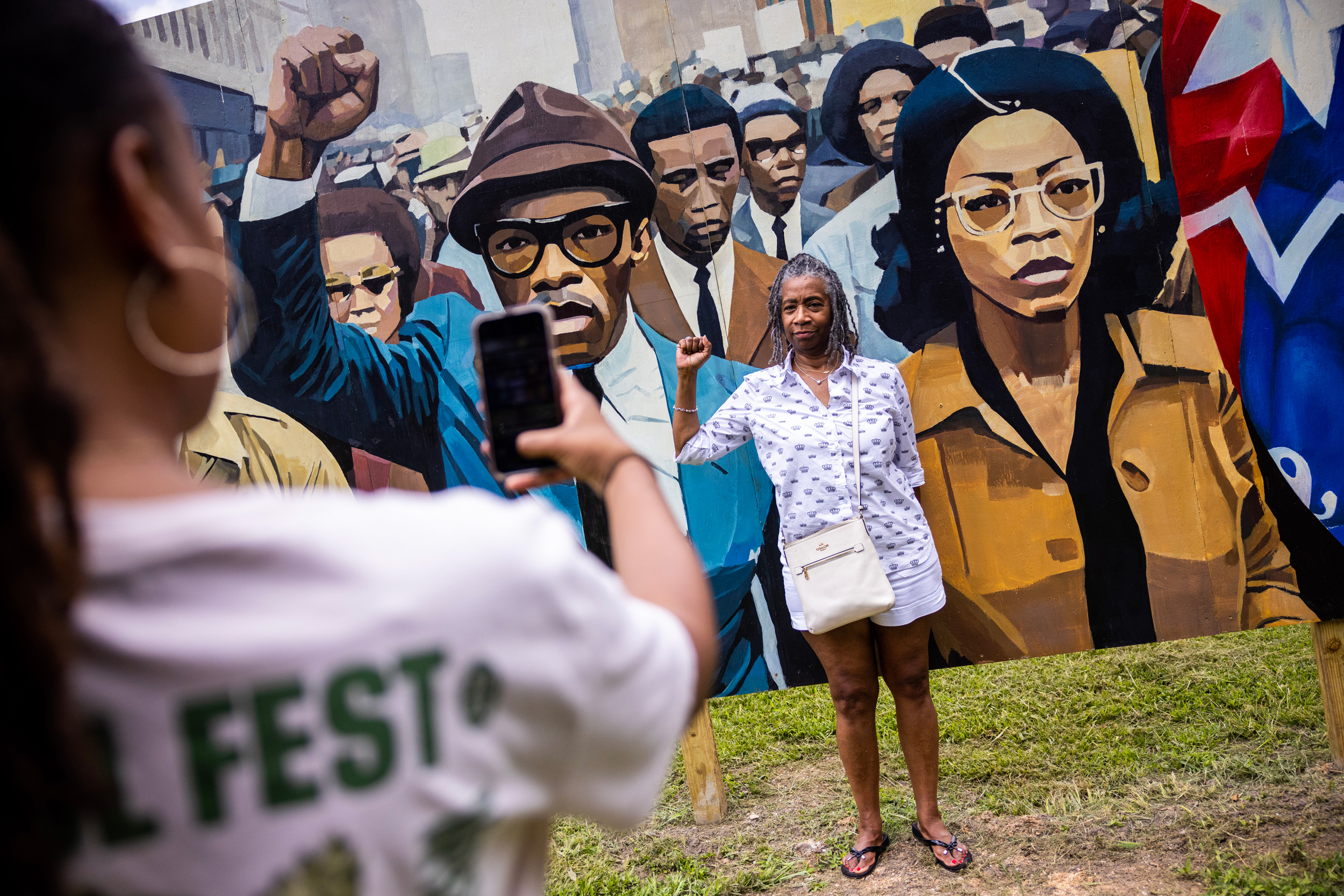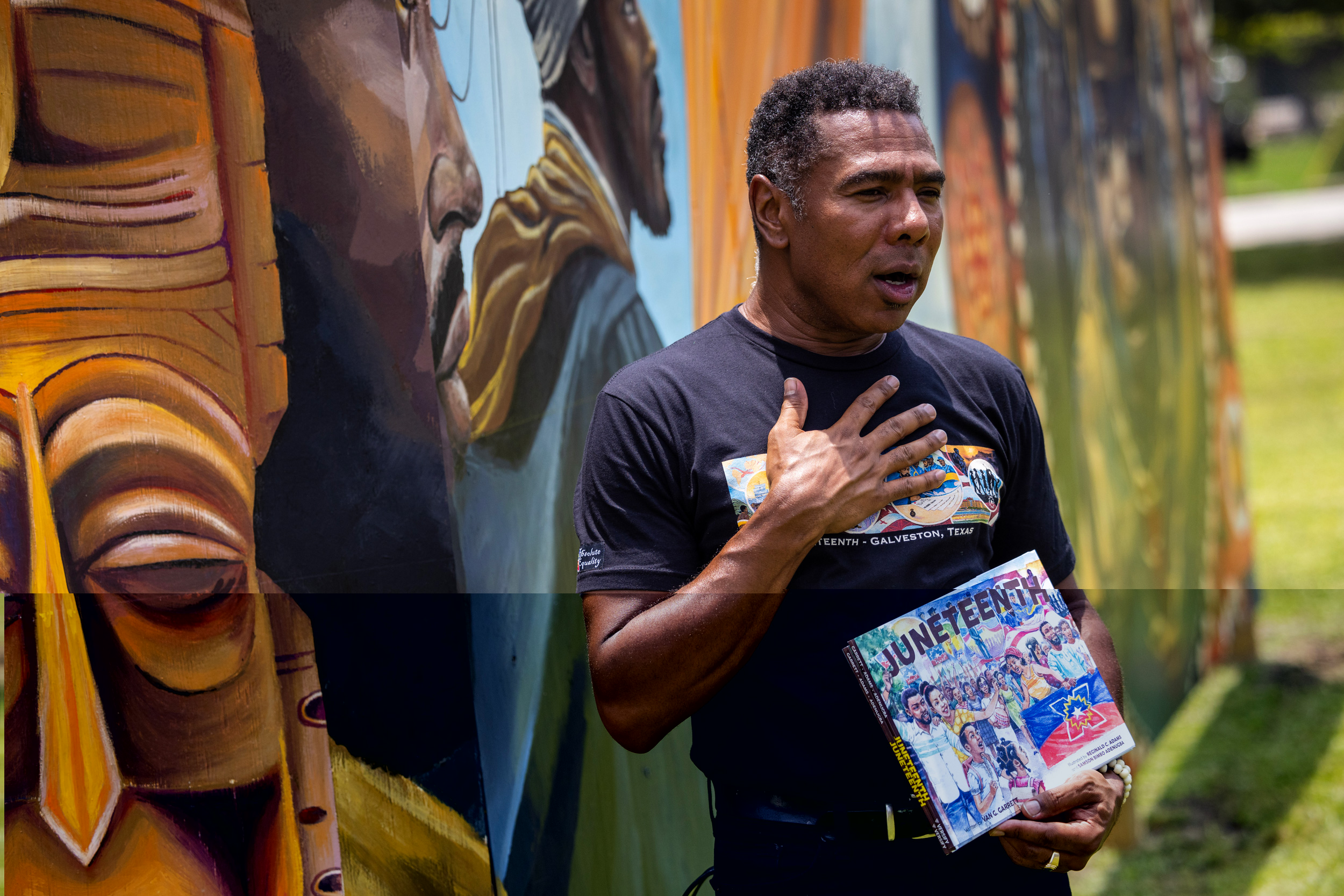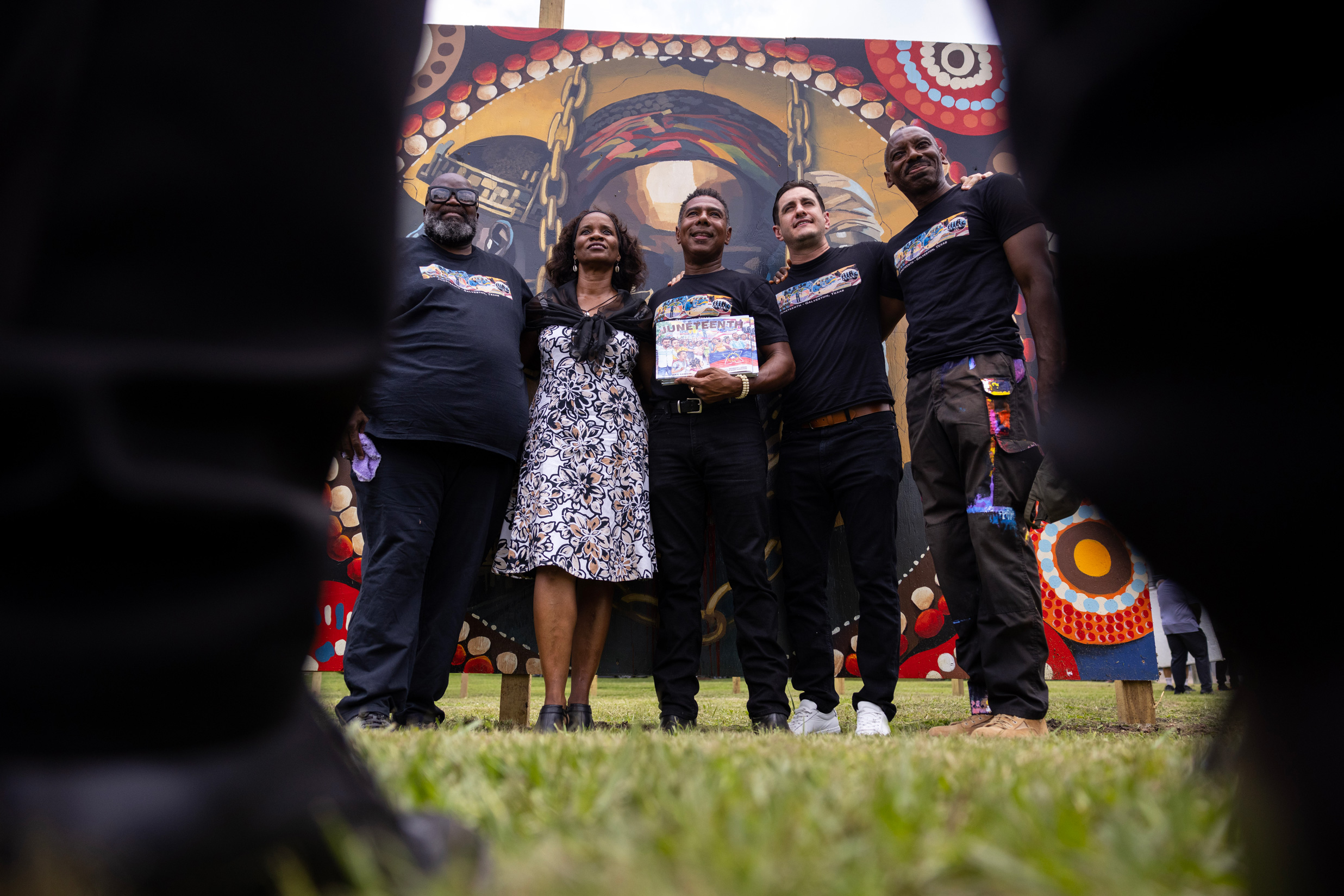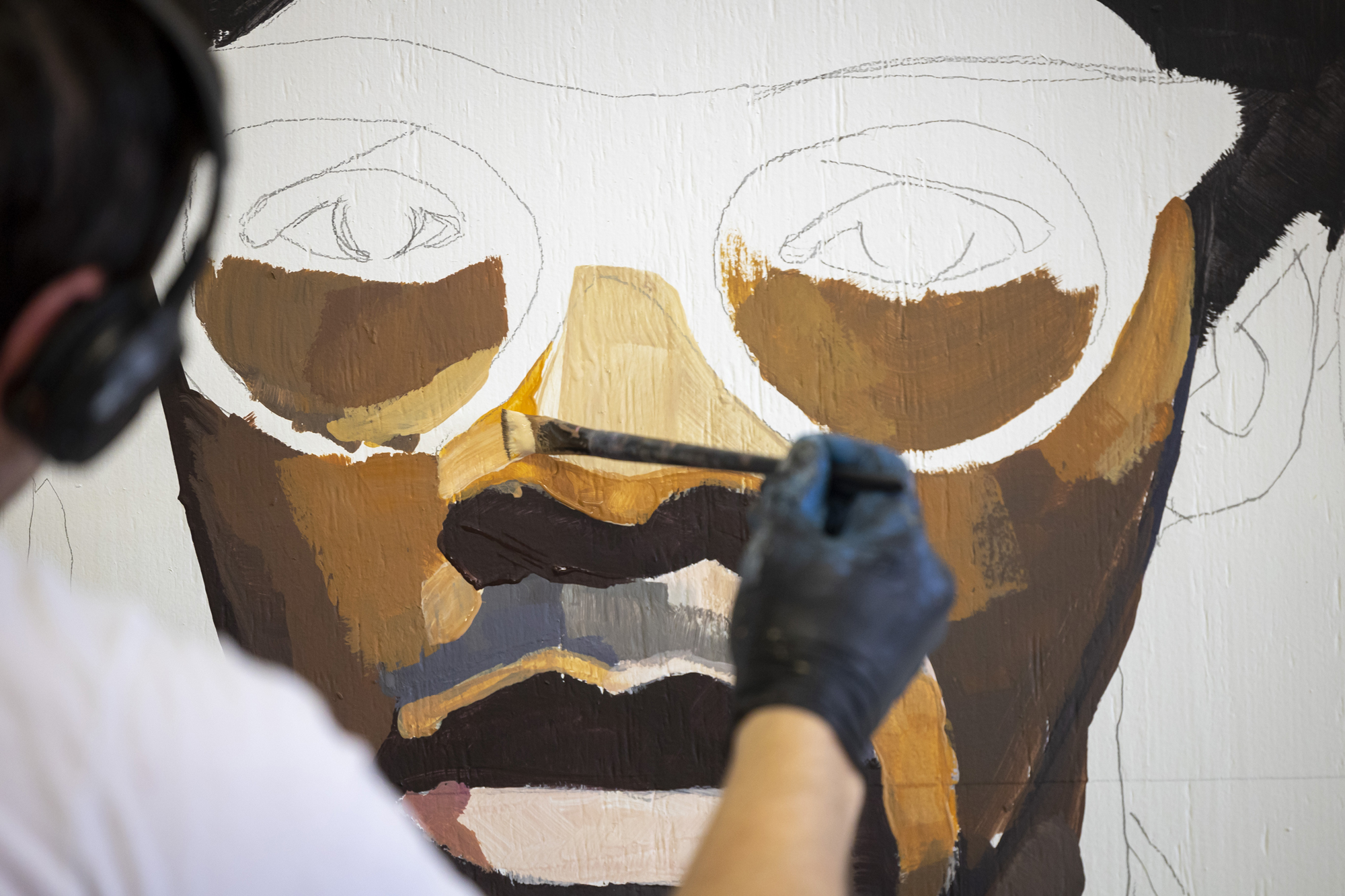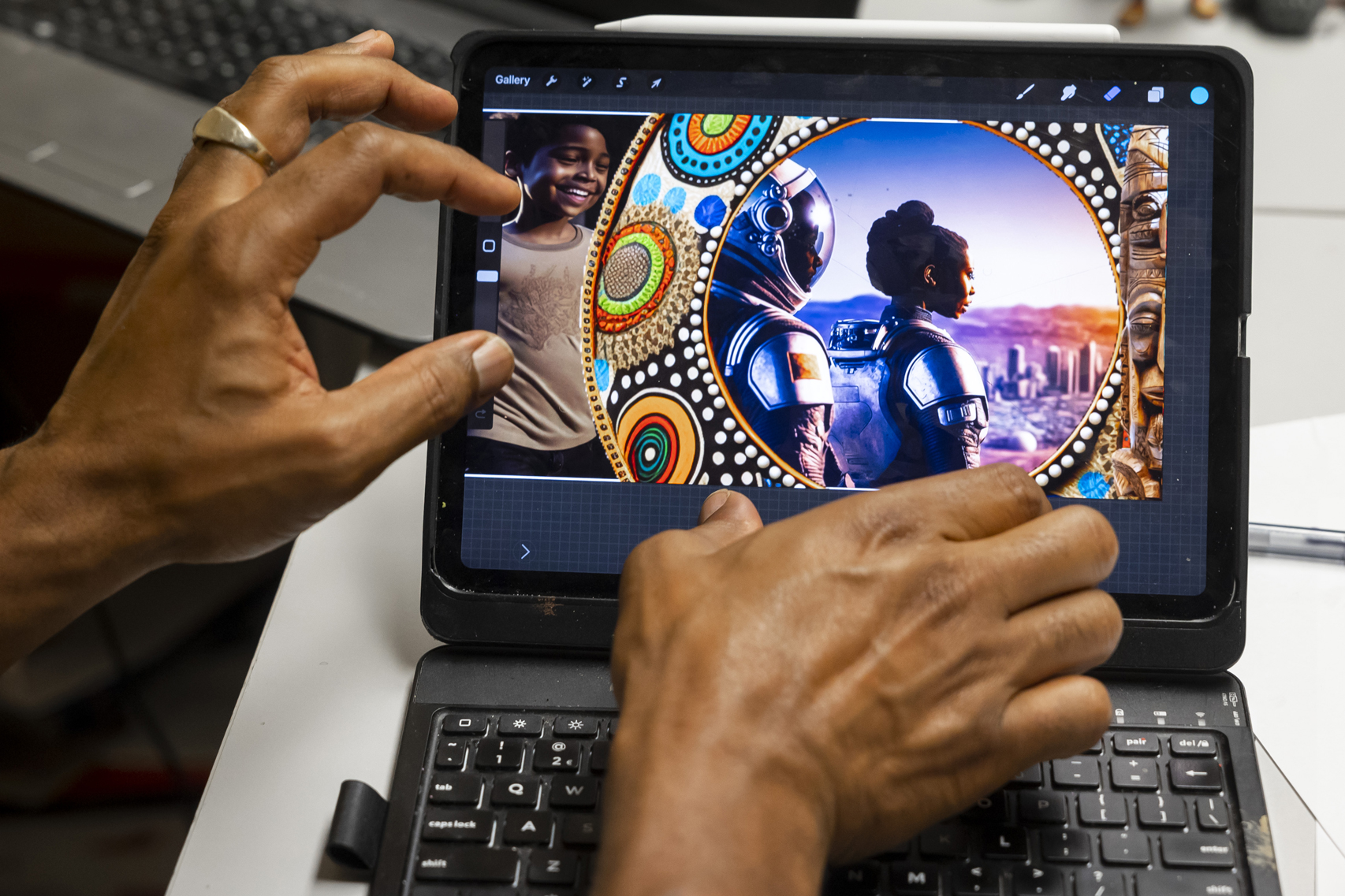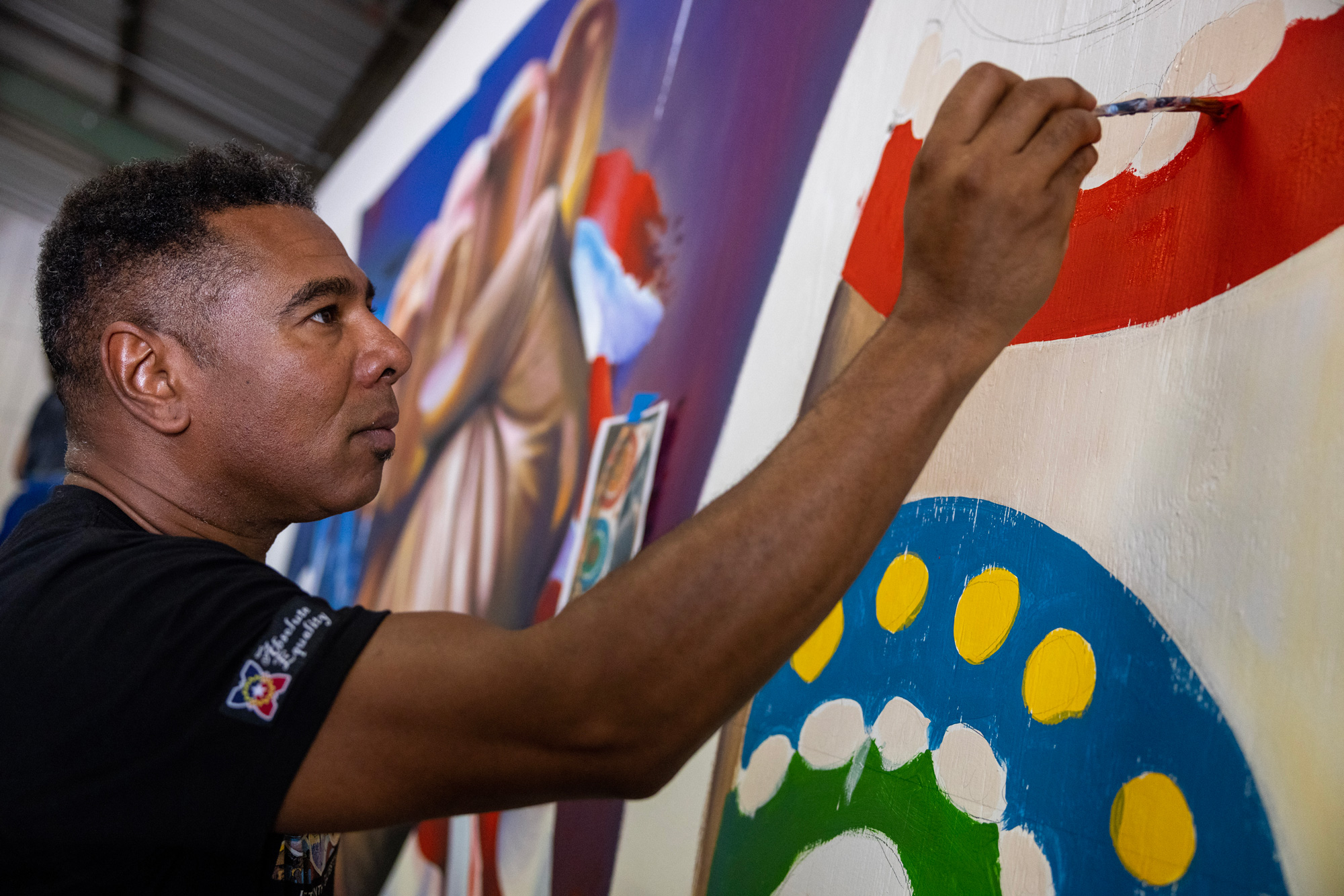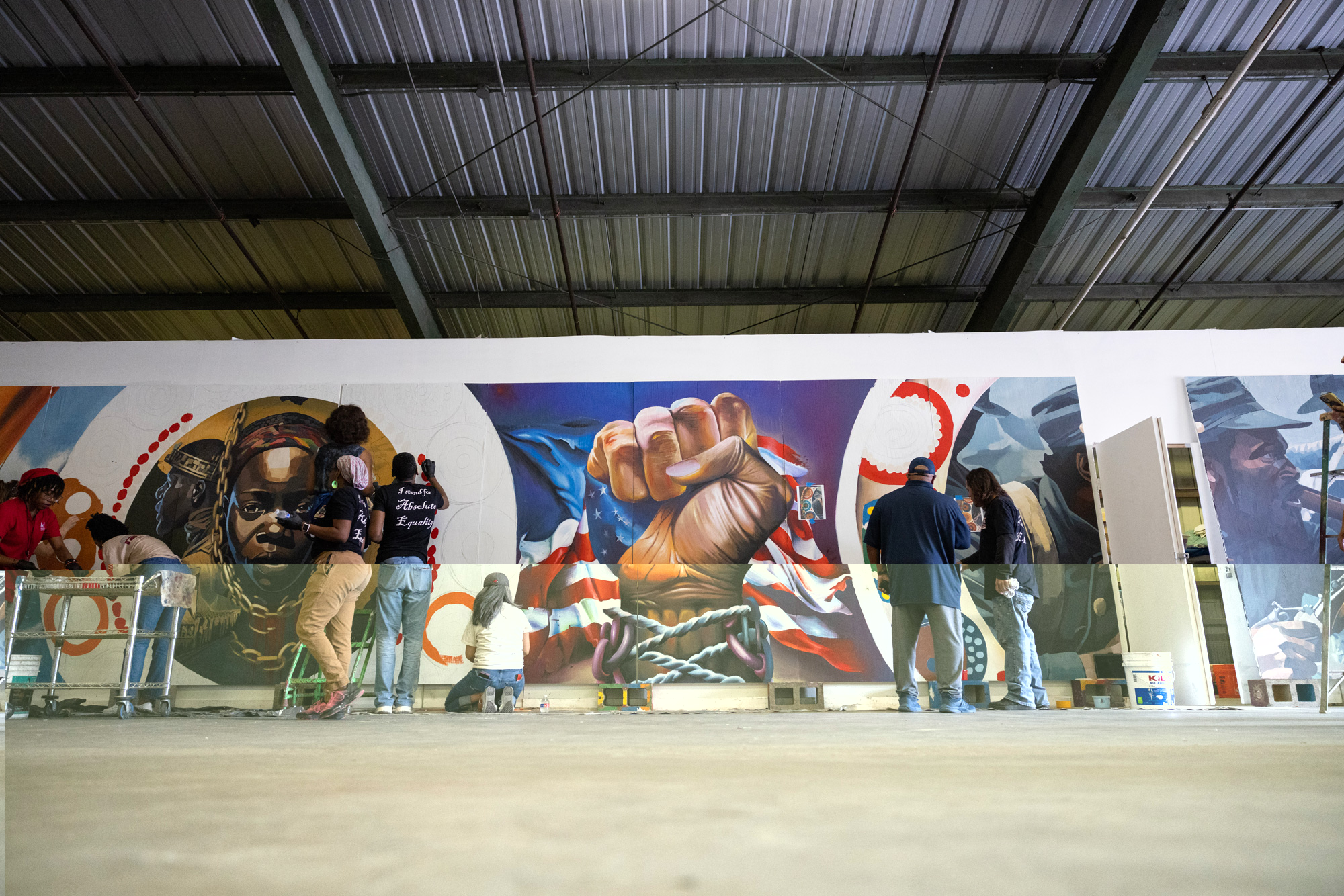|
Getting your Trinity Audio player ready...
|
Standing 30 feet in the air, supported by hydraulic boom lifts, Reginald Adams looked down and noticed a crowd forming underneath him, taking pictures.
It was a beautiful Saturday afternoon in the spring of 2021 as Adams and his team of five artists painted a 5,000-square-foot mural on the outside of the Old Galveston Square Building, commemorating the birthplace of Juneteenth. In that same spot 156 years before, Union army troops issued an order demanding “absolute equality,” freeing the last 250,000 enslaved Black Americans in Texas.
As Adams, one of Houston’s most renowned artists, took in the scene from the lift, he felt an overwhelming sense of pride — and had an epiphany.
“I thought, ‘Reginald, you are your ancestors' wildest imagination,’” Adams said. “Because 160 years ago, when we were being traded like cattle, cargo, lumber, in this very building, you're painting the story of freedom. And the fact that this is all I've ever done my whole life, I embody what happens when you're free. Because that's really what Juneteenth means to me.”
That now-famous mural, dubbed “Absolute Equality,” set the stage for Adams to become one of the nation’s leading figures entrusted with using public art to tell the story of Juneteenth, a federal holiday celebrated on June 19. Adams is unveiling six new Juneteenth murals created this year in partnership with local artists across the country — including one in Houston’s historic Freedmen’s Town community.
His local project, dedicated Wednesday, wraps around a 120-foot structure adjacent to the African American History Research Center at the Gregory School. The mural traces a journey of exploration and navigation, divided into windows of time stretching from the first slaves arriving from Africa to the modern-day halls of Congress.
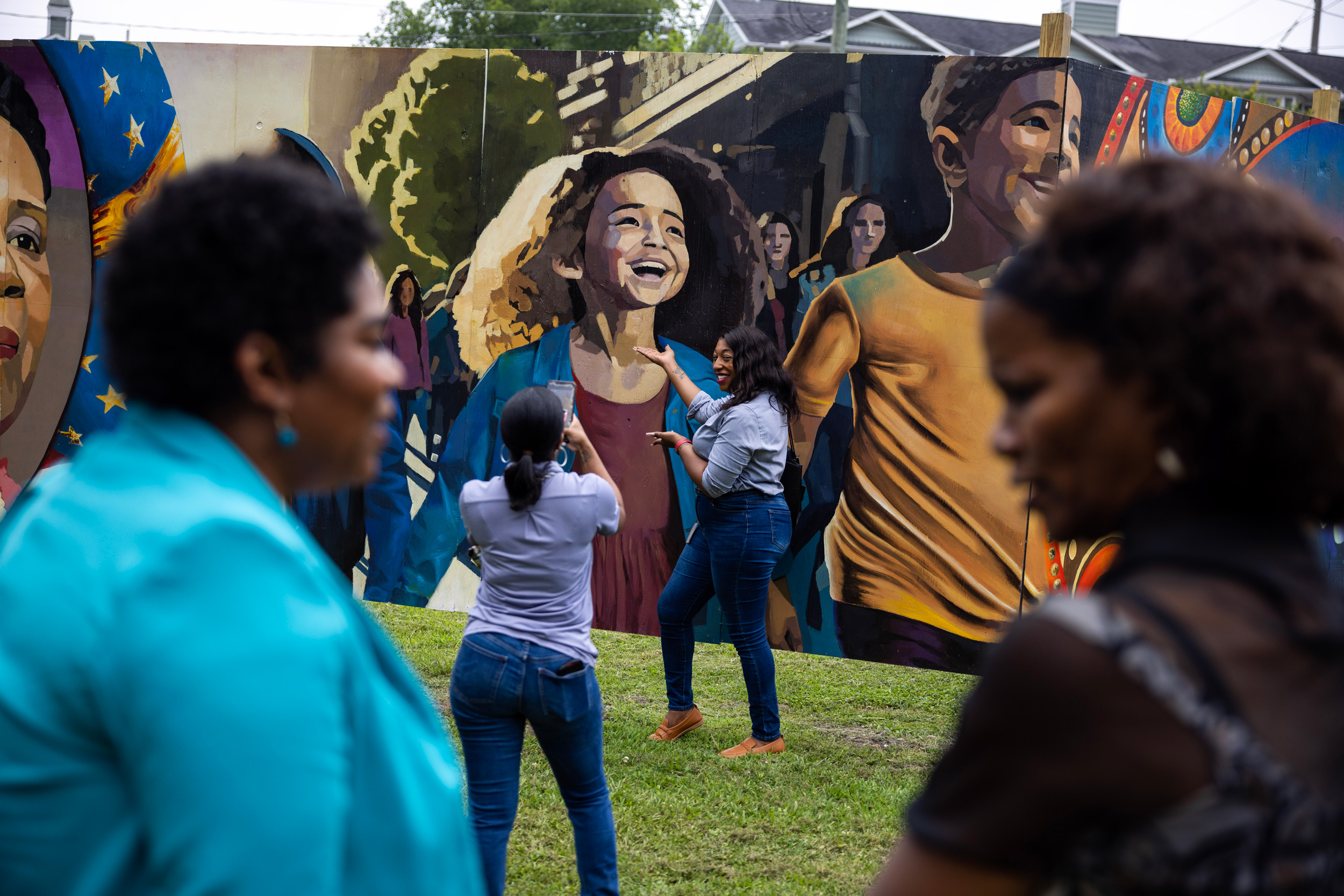
Each of the six murals embodies emancipation and the pursuit of social justice through the lens of Juneteenth. Local artists tailored murals to their community history, incorporating homages to inspirational leaders and iconic places.
It’s familiar territory for Adams, whose nearly 400 public art installations — including signature labyrinths, murals and mosaic sculptures — are in some of Houston’s most historic and underserved communities.
But by his own admission, Adams knew little about Juneteenth before a Galveston nonprofit, the Juneteenth Legacy Project, commissioned him to create “Absolute Equality.” Over the next few months, Adams dug deep into Juneteenth by gathering historical data, referencing old images, and talking to historians and community leaders.
He emerged with a mission to memorialize an event that he says hadn’t received enough public attention.
“While I heard about Juneteenth, I was very ignorant to what Juneteenth meant,” Adams said from his Third Ward studio. “Like many people, I was like, ‘Oh, you know, Texas got the word late.’ But there was more than that. So much more to it.”
‘It’s not going anywhere’
The Galveston “Absolute Equality” mural followed a national reckoning on racial justice brought on by the 2020 murder of Houston native George Floyd. It received a major boost when it was dedicated on June 19, 2021, two days after President Joe Biden signed a law establishing Juneteenth as the newest federal holiday.
While the story of Juneteenth originated in Galveston, Adams realized that every city has unique stories of social justice and the fight for racial equity. He also recognized that although Juneteenth was declared a federal holiday, Black people are still fighting for their absolute equality.
“We have a national holiday that honors this kind of strange holiday that most people don't know about and understand,” Adams said. “But I realized it's not going anywhere.”
So Adams set out to chronicle Juneteenth through the lenses of local public artists. He started with an ambitious vision to paint 10 Juneteenth-inspired murals last year, but ultimately only painted two: one in Shreveport, Louisiana, and another in Miami.
The Miami mural, however, caught the attention of Capital One Bank. The company later signed on as a corporate sponsor of his work and donated $150,000 to commission artists in additional cities — Chicago, Dallas, Detroit, Houston, Philadelphia — and another mural in Miami.
“One thing that attracted Capital One to ‘Absolute Equality’ was Reginald's passion for shining a light on and raising awareness of Juneteenth,” Capital One Community Engagement Lead Sean Skelly said in a statement. “Not only is he supporting some of the most talented artists in the country, he and his team are telling stories through art and helping spark real conversations in our communities.”
But that’s nothing new for people who know Adams best, like fellow local artist Joshua Bennett, who has worked with Adams on multiple projects in the past 15 years. Bennett described Adams as a “visionary,” recalling that his collaborator has continuously predicted the success of the Juneteenth murals.
“I know that every year it's going to grow and grow and grow, because it is American history. It is now an American holiday,” Bennett said. “And the attention that we're bringing and giving to it is the attention not only that it deserves, but is the attention that will be built on for generations to come, long after we're gone and the murals are still there.”
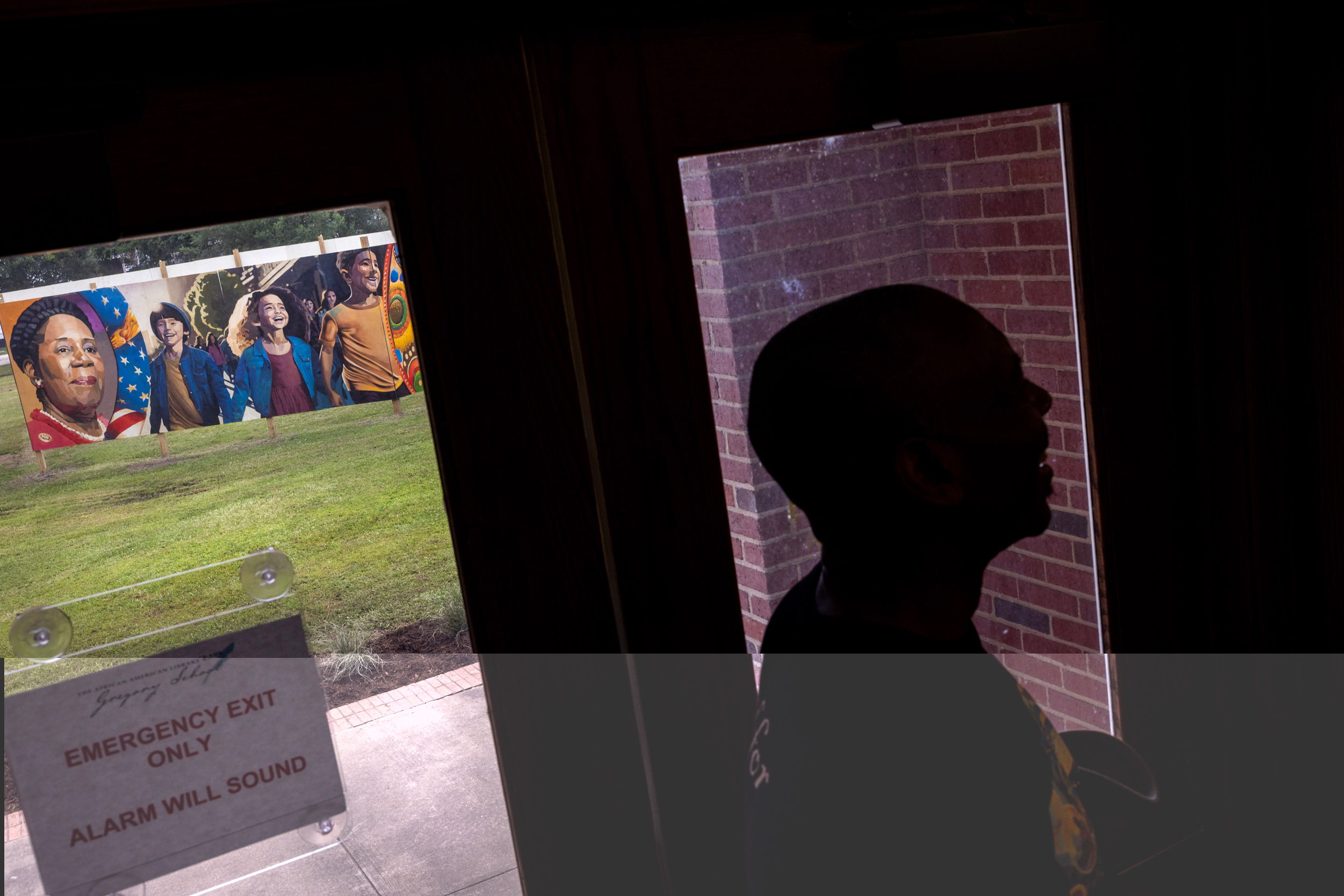
Houston’s Juneteenth mural
Adams and two of his studio’s artists, Santiago Perez and Prince Maduekwe, spent the past four months crafting Houston’s “Absolute Equality” mural in Freedmen’s Town.
The mural depicts nearly five centuries of history, spread out in a distinctive timeline. It begins with Africans landing in America, moves to scenes depicting the transatlantic slave trade and transitions into the Civil War. The mural then travels to June 1865, when Union Major Gen. Gordon Granger signed the emancipation orders in Galveston, accompanied by thousands of Black Union soldiers.
The journey continues with scenes from the civil rights movement and portraits of former state Rep. Al Edwards and current U.S. Rep. Sheila Jackson Lee, D-Houston, whose efforts spurred statewide and federal legislation making Juneteenth a holiday. Adams and his team intersperse children from different ethnic backgrounds walking together as a symbol of the pursuit for absolute equality. They end with a vignette of astronauts on a planetary landscape, a nod to Houston’s Space City reputation.
The work is designed to encourage viewers to question their attitudes toward race and ethnicity, and to think about the colonization of other planets, Adams explained to a group of community members during a workshop last month at his studio.
Adams hosted the community workshops as part of his approach to community-based art, allowing locals to paint parts of the mural outlined for them. It’s a way to teach a skill, empower those who don’t feel comfortable holding a paintbrush and foster pride in the work, he said.
“You take ownership … because now it's not just me and what I did. It's ours,” Adams said. “And if you live in the community and you helped to make it, you're going to take care of it. You're gonna look after it. You're gonna make sure no one destroys your work.”
The mural location, in the heart of the community known for its signature brick roads laid by 1,000 formerly enslaved people in 1865, naturally aligned with the Gregory School’s mission to tell the story of African American history.

“We're here to document the struggle, the perseverance, the resilience of the community,” said Miguell Ceasar, the research center’s manager and archivist.
Ceasar said he hopes the mural will draw people from all walks of life and bring communities together.
“African American history is American history,” Ceasar said. “And the more people know about Juneteenth … I feel like they can see similarities in between their own cultural history and may be able to be more sympathetic or more compassionate to the African American story.”
Longtime Freedmen’s Town advocates believe the mural can become a learning experience for children and families from across the city, sparking conversations about racial equality. They’re also excited about the potential for more foot traffic in the area, which was once the epicenter of prosperous Black life in Houston before it faltered in the mid-1900s.
Elmo Johnson, the pastor of Rose of Sharon Missionary Baptist Church in Freedmen’s Town, has already championed the work. He plans to bring his grandchildren, his church members and students at the Gregory Lincoln Education Center, where he volunteers.
“It means the world to me that this will be in Freedmen's Town,” Johnson said. “... I wish it could be all over Houston. But this is going to be beautiful in Freedmen’s Town. I love it.”
With the six murals installed, Adams is already thinking about next year: he hopes to reach 10 cities in 2024.

